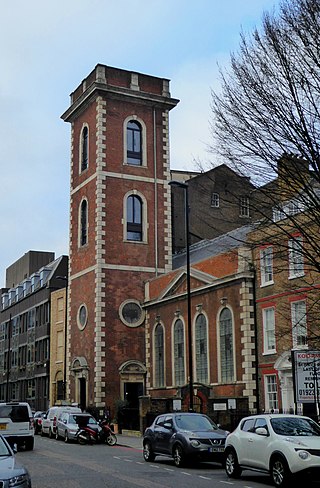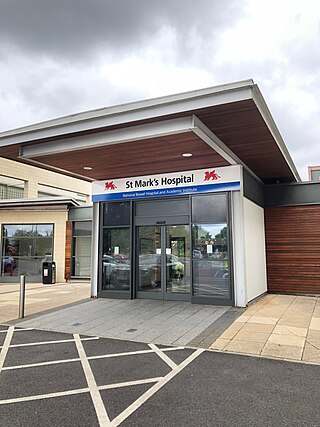
Joseph Lister, 1st Baron Lister, was a British surgeon, medical scientist, experimental pathologist and a pioneer of antiseptic surgery and preventative healthcare. Joseph Lister revolutionised the craft of surgery in the same manner that John Hunter revolutionised the science of surgery.

Surgery is a medical specialty that uses manual and/or instrumental techniques to physically reach into a subject's body in order to investigate or treat pathological conditions such as a disease or injury, to alter bodily functions, to improve appearance, or to remove/replace unwanted tissues or foreign bodies. The subject receiving the surgery is typically a person, but can also be a non-human animal.

St Thomas' Hospital is a large NHS teaching hospital in Central London, England. It is one of the institutions that compose the King's Health Partners, an academic health science centre. Administratively part of the Guy's and St Thomas' NHS Foundation Trust, together with Guy's Hospital, King's College Hospital, University Hospital Lewisham, and Queen Elizabeth Hospital, it provides the location of the King's College London GKT School of Medical Education.
The London Museums of Health & Medicine is a group that brings together some of the activities of several museums in London, England, related to health and medicine. The group was founded in 1991.

St Thomas Church, Southwark, London, England. The first church building was part of the original St. Thomas' Hospital which was located to the area around the present St Thomas Street, from the infirmary at St Mary Overie priory in 1212. The hospital was therefore also an Augustinian house. The hospital/conventual precinct became a parish no later than 1496. It was named after Thomas Becket whose cult pilgrimage to Canterbury began at London Bridge. The church was renamed St Thomas the Apostle following the abolition of the Becket cult in 1538 during the Reformation.

An operating theater is a facility within a hospital where surgical operations are carried out in an aseptic environment.

King's College Hospital is a major teaching hospital and major trauma centre in Denmark Hill, Camberwell in the London Borough of Lambeth, referred to locally and by staff simply as "King's" or abbreviated internally to "KCH". It is managed by King's College Hospital NHS Foundation Trust. It serves an inner city population of 700,000 in the London boroughs of Southwark and Lambeth, but also serves as a tertiary referral centre in certain specialties to millions of people in southern England. It is a large teaching hospital and is, with Guy's Hospital and St. Thomas' Hospital, the location of King's College London School of Medicine and one of the institutions that comprise the King's Health Partners, an academic health science centre. The chief executive is Dr Clive Kay. It is also the birthplace of Queen Camilla.

The Royal London Hospital is a large teaching hospital in Whitechapel in the London Borough of Tower Hamlets. It is part of Barts Health NHS Trust. It provides district general hospital services for the City of London and Tower Hamlets and specialist tertiary care services for patients from across London and elsewhere. The current hospital building has 845 beds and 34 wards. It opened in February 2012.

Sydney Hospital is a major hospital in Australia, located on Macquarie Street in the Sydney central business district. It is the oldest hospital in Australia, dating back to 1788, and has been at its current location since 1811. It first received the name Sydney Hospital in 1881.

James Syme was a Scottish pioneering surgeon.

Robert Liston was a British surgeon. Liston was noted for his speed and skill in an era prior to anaesthetics, when speed made a difference in terms of pain and survival. He was the first Professor of Clinical Surgery at University College Hospital in London and performed the first public operation utilizing modern anaesthesia in Europe.

The Thackray Museum of Medicine in Leeds, West Yorkshire, England, is a museum of the history of medicine adjacent to St James's University Hospital. It opened in March 1997 as the Thackray Medical Museum. In 1998 it won "Museum of the Year" and has other awards including in 2004 both the "Excellence in England Small Tourist Attraction of the Year" and "Sandford Award for Heritage Education".

The Royal Infirmary of Edinburgh (RIE), often known as the Edinburgh Royal Infirmary (ERI), was established in 1729 and is the oldest voluntary hospital in Scotland. The new buildings of 1879 were claimed to be the largest voluntary hospital in the United Kingdom, and later on, the Empire. The hospital moved to a new 900 bed site in 2003 in Little France. It is the site of clinical medicine teaching as well as a teaching hospital for the University of Edinburgh Medical School. In 1960, the first successful kidney transplant performed in the UK was at this hospital. In 1964, the world's first coronary care unit was established at the hospital. It is the only site for liver, pancreas and pancreatic islet cell transplantation and one of two sites for kidney transplantation in Scotland. In 2012, the Emergency Department had 113,000 patient attendances, the highest number in Scotland. It is managed by NHS Lothian.
In the United Kingdom, operating department practitioners (ODPs) are allied healthcare professionals who are involved in the planning and delivery of perioperative care. As the name suggests, they are primarily employed in surgical operating departments, but they may also work directly within a variety of acute clinical settings, including pre-hospital emergency care, emergency departments, intensive care units (ICUs), endoscopy suites, interventional radiology, cardiac catheter suites, obstetric theatres and reproductive medicine.

St Mark's Hospital, The National Bowel Hospital is a hospital in Park Royal, Greater London, England. Managed by London North West University Healthcare NHS Trust, it is the only hospital in the world to specialise entirely in intestinal and colorectal medicine and is a national and international referral centre for intestinal and colorectal disorders. It is the only hospital in the UK, and one of only 14 worldwide, to be recognised as a centre of excellence by the World Organisation of Digestive Endoscopy.
Russell Claude Brock, Baron Brock was a leading British chest and heart surgeon and one of the pioneers of modern open-heart surgery. His achievements were recognised by a knighthood in 1954, a life peerage in 1965, and a host of other awards.
Evan O'Neill Kane was an American physician and surgeon from the 1880s to the early 1930s who served as chief of surgery at Kane Summit Hospital in Kane, Pennsylvania. He was a significant contributor in his day to railway surgery; that is, the medical and managerial practices directed toward occupational health and accident-related trauma surgery for railroad workers. Kane was also a well published contributor of innovations in surgical procedures and equipment, including asbestos bandages, mica windows for brain surgery, and multiple site hypodermoclysis.

A hospital is a healthcare institution providing patient treatment with specialized health science and auxiliary healthcare staff and medical equipment. The best-known type of hospital is the general hospital, which typically has an emergency department to treat urgent health problems ranging from fire and accident victims to a sudden illness. A district hospital typically is the major health care facility in its region, with many beds for intensive care and additional beds for patients who need long-term care. Specialized hospitals include trauma centers, rehabilitation hospitals, children's hospitals, seniors' (geriatric) hospitals, and hospitals for dealing with specific medical needs such as psychiatric treatment and certain disease categories. Specialized hospitals can help reduce health care costs compared to general hospitals. Hospitals are classified as general, specialty, or government depending on the sources of income received.

The Miller General Hospital was a hospital in Greenwich, London from 1884 until 1974. It was developed adjacent to an earlier dispensary, and was the first British hospital designed with circular wards, and one of the first to have an X-ray department.

Eliza Roberts (1802–1878) was an English nurse who was among the first group of nurses to accompany Florence Nightingale to Scutari Hospital during the Crimean War. Nightingale regarded her as the best of her nurses and appointed her Head Nurse.


















